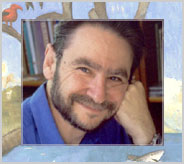 |
|
 |
 Although
I grew up in New York City, as a child I still managed to spend
a lot of time in treetops. I'd sit up there watching the people
and animals below, the clouds drifting above, and I'd listen to
the leaves around me rustling in the wind. I climbed big rocks —
like the one that inspired Will's Mammoth and The Boy
Who Loved Mammoths. Although
I grew up in New York City, as a child I still managed to spend
a lot of time in treetops. I'd sit up there watching the people
and animals below, the clouds drifting above, and I'd listen to
the leaves around me rustling in the wind. I climbed big rocks —
like the one that inspired Will's Mammoth and The Boy
Who Loved Mammoths.
Photo Credit:
Ariya Martin
My mother read fairy tales to me from
her beloved Book of Knowledge Encyclopedia. It was very old,
but the fairy tales in it were still exciting. She told me Aesop's
fables. One of our favorites was "The Tortoise and the Hare." "Slow
and steady wins the race" she would say, "slow and steady." (Since
I didn't write my first book until I was thirty-five, I clearly
followed that story's theme.)
I especially wanted to know what the
world had been like when my mother was young, before I was born.
To think of the world before I existed made everything I looked
at — the sun, the trees, a table or chair — more mysterious.
I remember, too, lying in bed when my mother read fairy tales to
me. In my mind I could see the great black raven, or the prince
riding through the dark forest, or Rapunzel letting down her long,
long hair. Yet none of these characters or things was even in the
room!
At holidays my father's family would
get together and talk about old times growing up together on New
York City's lower East Side. They were all first generation Russian
Jews. Family, a sense of humor, and stories had helped them face
hardship. They often told hysterically funny stories, but they were
not shy about talking about sad times, either. The stories were
hardly ever told by any one person. Everyone interrupted everyone
else, throwing in pieces, details, and changes so that the stories
grew, with each person throwing something of their own into the
pot. Those get-togethers made it clear that television was really
only a distant "second-best" to what words and a spirited storyteller
could bring alive.
From my father, who had flown Intelligence
and Rescue missions in the Himalayas in World War II, I heard tales
of rescues in the jungles, of elephants, tigers, cobras, and headhunters,
of holy men and beggars, and of pilots who flew off on days like
any other and never returned. I heard of ancient cities — Calcutta
and Bombay — and of mysterious rivers like the Ganges and Brahmaputtra.
From my grandmothers, who had each left their families at the age
of sixteen to come alone to America, fleeing the Revolution, I learned
of history and of the deep, quiet snows of Russian winters. In essence,
my family gave me what I most wanted and needed — stories.
Naturally, I loved to read. My favorite
books were myths and legends from around the world, stories about
King Arthur and the Knights of the Round Table and of Robin Hood
as well as any tales of animals. I especially loved Rudyard Kipling's
The Jungle Book. In sixth grade I found Herman Melville's
Moby Dick and read it over and over for many years. From
it I learned about whales, work, the sea and the imagination. From
it I learned, too, that a good storyteller can make you see with
your mind and believe what might, at first, have seemed impossible.
Through my wife Rose, new people, stories,
and words came into my life. But it wasn't until our children, Jacob
and Ariya, were born that my interest in sharing literature with
children began. Through sharing stories each night with them —
usually reading aloud but sometimes telling stories — I began
to understand how stories, when told out loud, come alive.
I have appeared as a visiting author
and storyteller in Japan, Hawaii, Alaska, and throughout the continental
United States. I've found that the personalities of the audiences
themselves shape the tale. My first children's books were published
in 1984 and 1985. In the process of writing books I've found that
I can't just take a story I tell, write it down, and presto! —
have a successful book. In working from a spoken story to a written
one I have to take back words and incidents and give the illustrator
room to show the story in his or her own way. I'm not interested
in making the illustrator see the story the way I do. For me a good
picture book is not just words and pictures but words and pictures
together producing something new.
Storytellers can only make sounds on
the air. A writer can only make squiggles on paper. Yet those who
hear or read those words can see, can feel and live, a whole life
in their minds. Every time I tell a story, each time I work on a
new book, this mystery lives for me again.
For more information about Rafe
Martin, please visit his Web site.
|
 |
 |